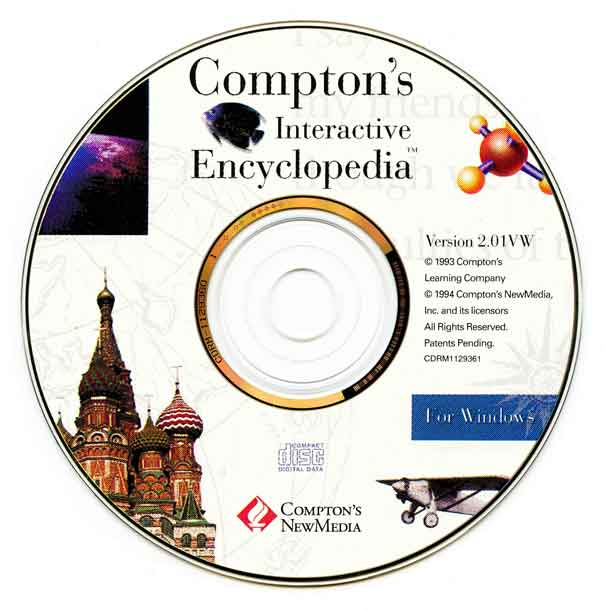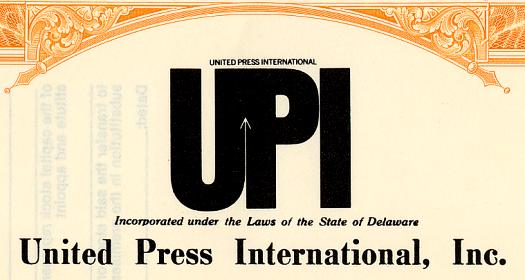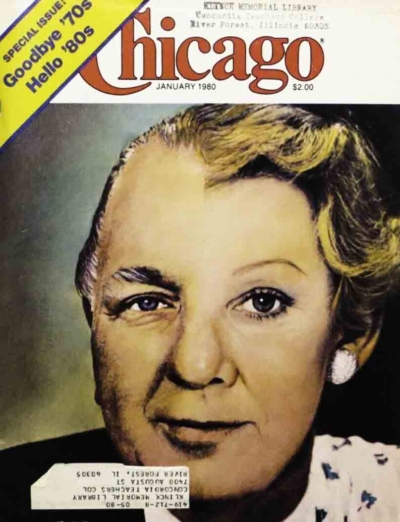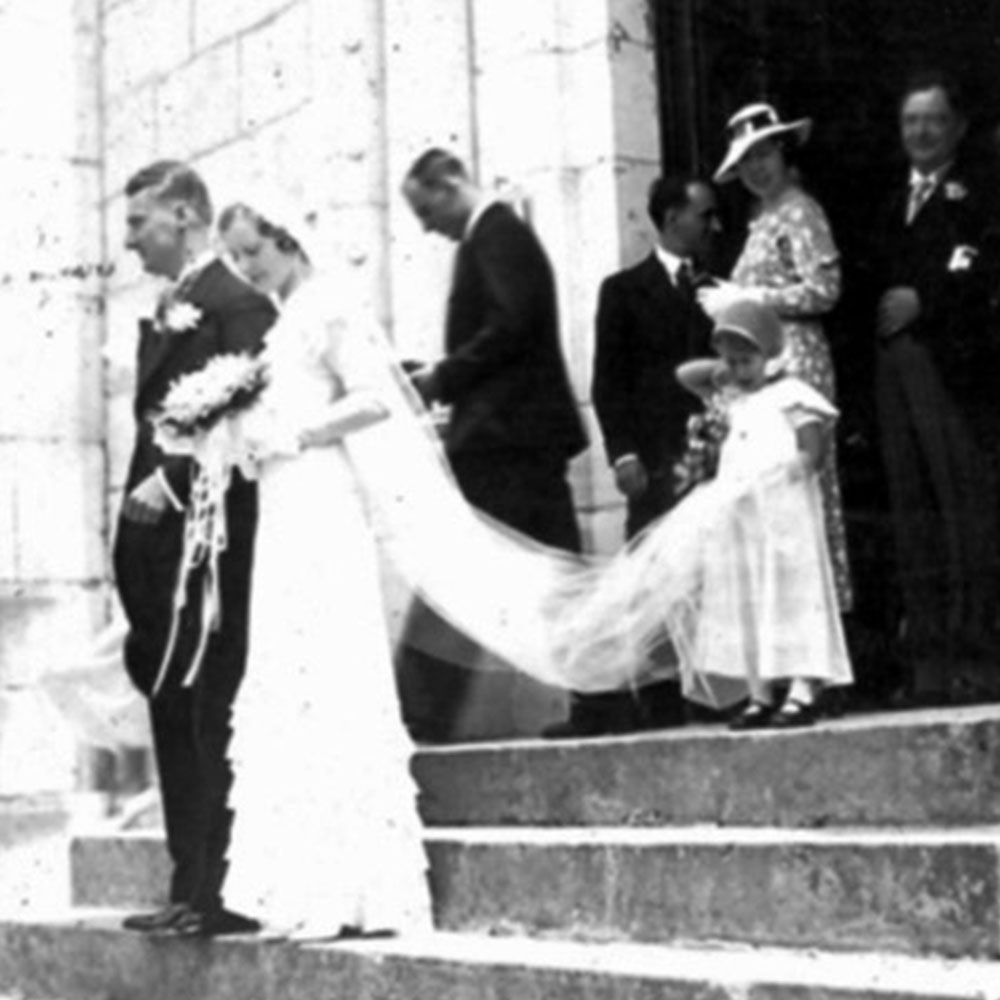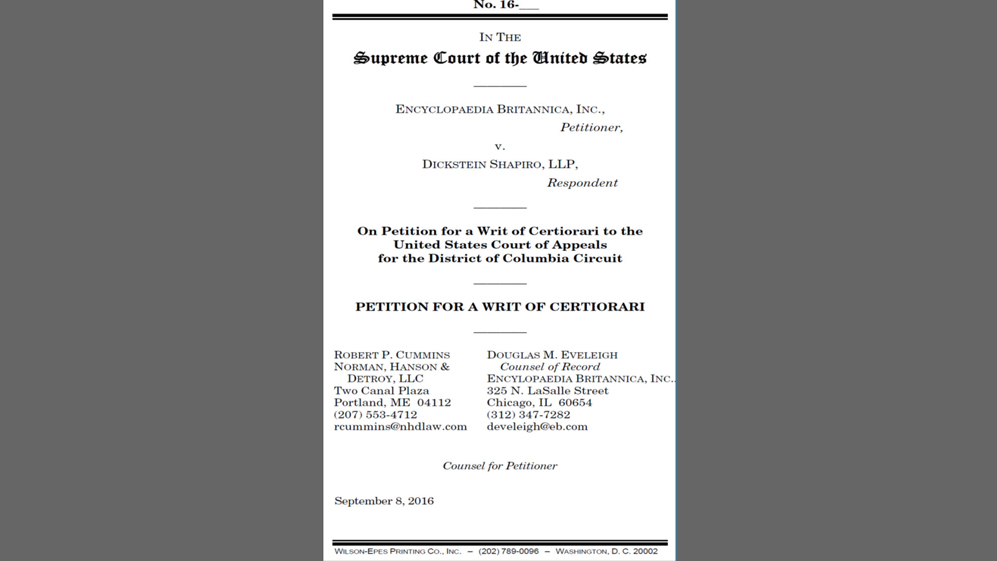
Encyclopaedia Britannica, Inc.
vs.
Dickstein, Shapiro, LLP

QUESTIONS PRESENTED
In the 1980s, Petitioner Encyclopaedia Britannica (“Britannica”) developed a pioneering multimedia search system that, for the first time, was able to search through vast amounts of multimedia information and display this information in a user-friendly manner. When Britannica sought to enforce patents obtained on this system, it was discovered that certain patent application filing errors committed by Respondent Dickstein Shapiro, LLP (“Dickstein”) rendered these patents invalid. Almost a decade later, Britannica’s malpractice case against Dickstein was dismissed on the pleadings in light of this Court’s precedent in Alice Corp. Party Ltd. v. CLS Bank International, 134 S. Ct. 2347 (2014), despite the presence of a pending motion to conduct discovery and factual disputes regarding whether the patents at issue presented an “abstract idea” or lacked “an inventive concept.”
- Did the District of Columbia Circuit err in holding, in contrast to the Seventh Circuit, that the “case-within-a-case” portion of a malpractice action is governed by jurisprudence arising after the malpractice injury rather than at the time of the injury?
- Can a patent be invalidated under 35 U.S.C.§ 101 and Alice on the pleadings, in the presence of factual disputes and a lack of evidentiary support that the patented invention is an “abstract idea” or that it lacks “an inventive concept?”
STATEMENT OF THE CASE
- In the 1980s, Britannica’s development of a user- friendly multimedia search system coincided with the coming of age of the personal computer in the consumer market. This fortuitous combination precipitated a remarkable cultural breakthrough. It meant that for the first time, children as well as adults could easily and quickly access and navigate complex and media-rich stores of digital information. The commercial embodiment of Britannica’s patented invention, found in one of its CD-ROM products called “Compton’s Encyclopedia,” was routinely praised in the industry:
“Compton’s Multimedia Encyclopedia is the first successful implementation of a product that combine words, pictures, and sound with an easy-to-use search engine. The product is incredibly adaptive to user’s needs. You can’t help but be impressed by Britannica’s courage and foresight in launching this product.”
Bill Machrone, 7th Annual Awards for technical Excellence, P.C. Magazine, January 15, 1991, 112.
Newsweek also took notice:
“Computers aren’t just smart typewriters and zippy number crunchers anymore. . . Yet, so far hype has outstripped hopes in the growing collection of multimedia programs. Like dazzling Hollywood flops, most have turned out to be long on technology, but short on substance. Until Compton’s. . . Just getting that much information on a disc is impressive enough. Yet the beauty of Compton’s is in the links— everything is woven together so the user can quickly move between related bits of information. Thanks to ingenious design, the program is so simple that, literally, a child can use it. . . Hit a difficult word? A click will bring up the definition—and if your PC has sound capability, the machine will even pronounce it for you.”
John Schwartz, A Computer Encyclopedia, Newsweek Magazine, March 19, 1990, 45.
In 1989, just before Encyclopaedia Britannica published the Compton’s Encyclopaedia product, it filed a patent application with the assistance of Respondent Dickstein. This patent covered funda- mental new aspects of the software architecture and the pioneering search system attuned to multimedia data. The patent was not limited to an encyclopedic environment or CD-ROMs. Instead, it dealt with the fundamental solution to the search, browse, and presentation issues affiliated with different types of electronic data.
The Patent and Trademark Office spent four years reviewing Britannica’s patent application, making sure that there were no prior inventions covering the claimed invention. When the patent was finally issued to Encyclopædia Britannica in 1993, it was immediately recognized as a highly significant patent by the then nascent multimedia industry. Thereafter, President Clinton’s newly appointed patent commissioner, Bruce Lehman, took the unusual step of ordering a reexamination of the patent. After a further nine-year, painstaking review, with a side trip to Federal court, the Patent Office reinstated the Britannica patent in 2002 and issued several continuation patents thereafter.
- In 2006, Britannica sued Alpine Electronics of America, Inc. and other defendants in the District Court for the Western District of Texas for infringing two of Encyclopaedia Britannica’s most-valuable patents: United States Patents Nos. 7,051,018 (“the ’018 Patent”) and 7,082,437 (“the ’437 Patent”). See W.D. Tex. #1:06-cv-00578-LY, Dkt. 1. Following suit, Alpine and the other defendants moved for summary judgment. The court granted judgment and found the patents to be invalid. Id. at Dkt. 82. This finding of invalidity was the direct and proximate result of Dickstein Shapiro’s malpractice. The essence of the court’s ruling was that due to patent application filing errors committed by Dickstein, an earlier Encyclopaedia Britannica publication was “prior art” sufficient to invalidate the patents in suit. But for Dickstein Shapiro’s negligence, that so-called “prior art” would not have been of any significance. Id.
More particularly, the ’018 and ’437 patent applications were filed based on a “priority date” claim of 1989 through a chain of patent applications. Not unlike filing a series of amended pleadings under Rule 15(c) that “relate back” and have the benefit of an original complaint (and, thus, avoid a statute of limitations defense), a series of patent applications can be based on an original application and thus have the benefit (i.e., claim the “priority”) of that original patent filing. This continuity is critical in the patent context so that intervening acts, events, or publications do not threaten the validity of those patents that emanate at the end of the chain.
In order to sustain that priority date, certain specific statutory and patent office requirements have to be satisfied. Satisfaction of these requirements is routine for members of the patent bar. However, Dickstein’s malpractice caused the priority chain for the applications leading to the ’018 and ’437 patents to be broken, thus exposing those patents to being invalidated.
REASONS FOR GRANTING THE PETITION
The decision below contradicts not only the law of another circuit, but also a fundamental tenet of malpractice cases: in a “case-within-a-case” context, it is the jurisprudence existing at the time of injury that applies, and not after-developed law. This also is sheer common sense − it is unrealistic to adjudicate a case-within-a-case and attorney malpractice based on decisions that have not yet been handed down.
The decision below also exposes what is becoming a common practice by lower courts dismissing patent cases on Rule 12 motions under 35 U.S.C. §101 and Alice, despite the presence of factual issues and a lack of discovery, claim construction and evidence. Guidance is needed by this Court to rein in what has essentially become a judicial end-run around the standards set by this Court under Rule 12.
THIS COURT’S REVIEW IS NEEDED TO RESOLVE A CIRCUIT SPLIT REGARDING THE JURISPRUDENCE TO APPLY IN A “CASE-WITHIN-A-CASE” MALPRACTICE ACTION
Contrary to the decision below, the standard of care by which Dickstein Shapiro’s conduct must be judged and the proximate cause determination within the “case-within-a-case” that must be made is controlled by the law that applied in 2009, which is when the Britannica patents were invalidated in the Texas District Court. See W.D. Tex. #1:06-cv-00578-LY, Dkt. 82. Indeed, for determining malpractice liability, an attorney’s conduct is to be viewed in the context of events prevailing at the time of the alleged malpractice, not in light of subsequent developments. Biomet, Inc. v. Finnegan Henderson, LLP, 967 A.2d 662, 668 (D.C. 2009), aff’d. A plaintiff suffers “injury” in the context of legal malpractice when he suffers a “loss or impairment of a right, remedy, or interest.” Jones v. Lattimer, No. CV 12-2050 (BAH), 2014 WL 869470 (D.D.C. Mar. 6, 2014) (citing Hunt v. Bittman, 482 F. Supp. 1017, 1020 (D.D.C. 1980) aff’d, 652 F.2d 196 (D.C. Cir. 1981) (“In determining when a legal malpractice claim ‘accrues,’ the District of Columbia follows the so-called ‘injury’ rule. Under this rule, a claim for legal malpractice accrues when the plaintiff-client suffers actual injury.”).
Here, the loss or impairment of Encyclopaedia Britannica’s rights occurred no later than 2009 (when the patents were invalidated in the Texas litigation), five years before the Supreme Court’s decision in Alice. That is the relevant law that should be applied to the case-within-a-case analysis here, not Alice. Perhaps the clearest articulation of this bedrock principle is found in the Seventh Circuit’s A.O. Smith Corp. opinion as follows:
Dismissal of the tort action was not appropriate here. The opinion below undertakes an exhaustive but unnecessary tour through recent antitrust case law in the Supreme Court and in this Circuit. The District Court decision, dwelling as it does on a number of cases decided after the 1985 trial, assumes that the relevant question is whether proof of tied market power is required now, not whether it was required at the time of trial. This view cannot be correct. Both Illinois law governing legal malpractice actions and common sense suggest that an attorney’s performance at trial must be evaluated by the state of the jurisprudence at the time of trial.… After all, it would be manifestly unfair to expect lawyers in the midst of trial to predict how the circuit courts and the Supreme Court will shape new legal doctrine. The District Court relied on certain decisions subsequent to the 1985 trial because they were decided “closely on the heels of the antitrust trial” and these precedents might have been taken into account on appeal. The logic behind this reasoning is elusive. Though it might in some sense be easier to predict the near future than the distant future, it is nevertheless quite unrealistic to judge lawyers in a malpractice action by decisions that have not yet been handed down. A.O. Smith Corporation v. Lewis, Overbeck & Furman, 979 F.2d 546, 549 (7th Cir. 1992) (emphasis added).
In like manner, the District of Columbia Court of Appeals previously (and correctly) held that it is the state of the law at the time of the lawyer’s action or inaction that controls, and not subsequent legal developments. Biomet, Inc., 967 A.2d at 668 (“Whether [Defendant’s] strategy of challenging only liability in the initial appeal was reasonable requires consideration of the state of the law regarding constitutional challenges to excessive punitive damages at the time of the appeal.”).
The 2014 “developments in patent law” represented by Alice constituted a sea change in the patentability of computer software. Dickstein should not be able to escape liability by relying on these recent developments. Indeed, if Alice applies retroactively to invalidate Britannica’s patents, then it necessarily means that Dickstein repeatedly deceived its client Britannica and breached its fiduciary duties at least by: (1) pursuing the ’018 and ’437 patents in the first place; and (2) prosecuting these patents before the USPTO. Accordingly, Dickstein’s malpractice must be viewed through the lens of the law that existed at the time of the summary judgment decision in the Texas litigation, not five years later using the after- developed Alice decision. This is the way in which the Seventh Circuit views the issue, which is contrary to the decision below by the D.C. Circuit. Accordingly, this Court’s review is needed to restore certainty surrounding the jurisprudence that applies to malpractice actions.
THIS CASE PRESENTS AN IMPORTANT QUESTION THAT INTERSECTS RULE 12 DISMISSALS AND ALICE, WARRANTING REVIEW BY THIS COURT
The decision below held, in the context of a 12(c) motion to dismiss on the pleadings, that Britannica’s patents were invalid under 35 U.S. C. § 101. This ruling was made despite the fact that the parties had not conducted any discovery on the Section 101 issue and despite the presence of factual issues. The Court’s review is necessary to provide clarification regarding the standards to be used when evaluating a motion to dismiss under Section 101 and the Court’s precedent in Alice. As the Federal Circuit has noted, the analysis under Section 101 is a legal determination rife with underlying factual issues. In re Comiskey, 554 F.3d 967, 976 (Fed. Cir. 2009). In addition, the standards surrounding a Rule 12 motion are by now axiomatic: to survive a motion to dismiss under Federal Rule of Civil Procedure 12, a plaintiff need only plead “enough facts to state a claim to relief that is plausible on its face” and to “nudge[ ] [his or her] claims across the line from conceivable to plausible.” Bell Atl. Corp. v. Twombly, 550 U.S. 544, 570, 127 S. Ct. 1955, 167 L. Ed. 2d 929 (2007). A Rule 12 motion “shall be granted if the moving party demonstrates that no material fact is in dispute and that it is entitled to judgment as a matter of law.” Stewart v. Evans, 275 F.3d 1126, 1132, 348 U.S. App. D.C. 382 (D.C. Cir. 2002) (internal quotation marks omitted). In deciding a motion under Rule 12(c), “courts employ the same standard that governs a Rule 12(b)(6) motion to dismiss.” Lans v. Adduci Mastriani & Schaumberg L.L.P., 786 F. Supp. 2d 240, 265 (D.D.C. 2011); see also Brooks v. Clinton, 841 F. Supp. 2d 287, 297 (D.D.C. 2012). “[T]he Court may not rely on facts outside the pleadings and must construe the complaint in the light most favorable to the non-moving party.” Id. (citation omitted); see also Moore v. United States, Nos. 99-5197, 99-5198, 213 F.3d 705, 341 U.S. App. D.C. 348, 2000 U.S. App. LEXIS 12038 (D.C. Cir. 2000) (noting that “on Rule 12(c) motions we view the facts presented in the pleadings and the inferences to be drawn therefrom in the light most favorable to the nonmoving party”) (citations and internal quotation marks omitted); Schuchart v. La Taberna del Alabardero, Inc., 365 F.3d 33, 34, 361 U.S. App. D.C. 121 (D.C. Cir. 2004) (Under Rule 12(c), facts “must be read in the light most favorable to the non-moving parties . . . granting them all reasonable inferences”) (citing Henthorn v. Dept. of Navy, 29 F.3d 682, 684, 308 U.S. App. D.C. 36 (D.C. Cir. 1994)). Thus, a motion to dismiss should be denied if plaintiffs have shown “a plausible entitlement to relief.” Bell Atl. Corp. v. Twombly, 550 U.S. 544, 559 (2007).
If, on a motion under Rule 12(c), “matters outside the pleadings are presented to and not excluded by the court, the motion must be treated as one for summary judgment under Rule 56.” Fed. R. Civ. P. 12(d); Ord v. District of Columbia, 587 F.3d 1136, 1140, 388 U.S. App. D.C. 378 (D.C. Cir. 2009) (internal citations and quotation marks omitted); see also Vest v. Dep’t of the Air Force, 793 F. Supp. 2d 103, 112 (D.D.C. 2011); Dormu v. District of Columbia, 795 F. Supp. 2d 7, 17 n.4 (D.D.C. 2011); Strong-Fischer v. Peters, 554 F. Supp. 2d 19, 22 (D.D.C. 2008).
Under the strict standard for Rule 12 dismissals, and taking into account the presumption of validity that all patents enjoy under 35 U.S.C. § 282, the district court only should have granted Dickstein’s motion if the pleadings showed by clear and convincing evidence that the patent is invalid. Nystrom v. TREX Co., 424 F.3d 1136, 1149 (Fed. Cir. 2005) (“[a] party seeking to establish that particular claims are invalid must overcome the presumption of validity in 35 U.S.C. § 282 by clear and convincing evidence”)(quoting State Contracting & Eng’g Corp. v. Condotte Am., Inc., 346 F.3d 1057, 1067 (Fed. Cir. 2003)). Accordingly, under this Court’s precedent in Alice, Respondent’s motion to dismiss below should have been denied if the only plausible reading of the Britannica patents showed, by clear and convincing evidence, that they were a mere “abstract idea” and did not contain an “inventive concept.” When the factual allegations in Britannica’s complaint and patents are viewed in the light most favorable to Britannica, there are, at the very least, material factual disputes that should not have been resolved by the court below on a motion to dismiss. Indeed, the patents state:
- Recently, there has been a rapidly growing interest in using CD-ROM technology as a dynamically interactive way of presenting material contained in books, encyclopaedias, magazines, catalogs, etc. CD-ROMS offer a set of characteristics that are unique for this purpose. First, they have a very high information storage density (approximately 50 times magnetic mate- rial), rapid random access of addressable information, low cost mass produced copies, and relatively low cost playback equipment. Second, by interfacing a CD- ROM player and CRT monitor to a computer, stored audio/visual data can be accessed interactively in a variety of user friendly ways. Yet with this explosion in storage capacity and quality, there arises a need for software that readily and easily accesses this full spectra of data in a user friendly manner. (’437 Patent, Column 1. lines. 20-36)
- In view of the foregoing, it should be apparent that a need still exists for a database search system that retrieves multimedia information in a flexible, user friendly system. It is, therefore, a primary object of the invention to provide a search system in which a multimedia database consisting of text, picture, audio and animated data is searched through multiple graphical and textual entry paths. (Id., Column 2, lines 35 to 41).
- It is a further object of the invention to provide a search system wherein both the textual and graphical entry paths are interactive. (Id., Column 2, lines 42 to 44).
- It is yet an additional object of the invention to provide for a search system where the textual and graphical entry paths are interrelated such that textual and graphical entry paths is fully accessible from graphical entry paths and graphical information is fully accessible from textual entry paths. (Id., Column 2, lines 45 to 49).
Further, Britannica plausibly set forth in the court below that the inventions embodied in the patents were not “abstract ideas” and contained an “inventive concept,” which should have been enough to survive a motion to dismiss. As stated in the court below, the inventions were directed to a new system to search a database. (’437 patent, Column 2, lines 35 to 40). Searches, called entry paths, can be based on text or graphical images, including article titles (Id., Column 4, lines 27 to 29), pictures (Id., Column 4, lines 36 to 45), a world atlas (Id., Column 4, lines 53 to 54), and a researcher assistant’s program (Id., Column 4, lines 63 to 64). Entry paths are interactive; use of one can lead to pertinent information in another path. (Id., Column 2, lines 42 to 49). There are other paths, too: idea search, title finder, topic tree, and history timeline. (Id., Column 6, lines 51 to 60). Each is discussed in detail in the patents.
The database includes audio and video sequences. (Id., Column 6, lines 31 to 44). For example, if a user clicks on an underlined word in an article, the invention provides an audio pronunciation of the word. (Id., Column 11, lines 41 to 50). The atlas can be searched by a place name, which displays a map of the place that can be viewed in different levels of detail. (Id., Column 4, lines 55 to 62). The atlas can be rotated to locate a place of interest. (Id., Column 4, lines 55 to 57). A user can click on the place name, which automatically retrieves a related article. (Id., Column 7, lines 27 to 32). The invention also keeps track of searches, and can flag materials that appear to be more relevant. (Id., Column 8, lines 45 to 48 and lines 56-64). It suggests alternate search terms, and can search using phrases, too. (Id., Column 9, lines 21 to 31 and Column 10, lines 15 to 25).
Prior systems and methods lacked the versatility of the invention. The patents state:
Despite the great potential for interactive CD-ROM systems, however, many of the current commercially available versions have important limitations in meeting this need. These limitations include products lacking entry paths into the CD-ROM database to retrieve graphical information, products that cannot flexibly search and retrieve different types of data formats, or products that will not allow the combination of search strategies to uncover graphical and related textual information or vice versa. (Id., Column 1, lines 36 to 44). It is also worthy to note that there were 111 patents and over 400 other publications cited against the Britannica patents. See, e.g., ’437 Patent, pages 2-15. In light of this magnitude of references considered by the patent office when granting Britannica’s patents, it defies logic that the patents were dismissed by the court below at the pleadings stage for lack of an “inventive concept.”
The pioneering nature of Britannica’s patents were also routinely touted by Respondent prior to being sued for malpractice. Indeed, Respondent proclaimed that the inventive concept underlying the inventions of the ’018 and ’437 patents was previously “unimaginable,” like most breakthrough inventions. See D.C. 10-CV-00454, Dkt. # 78-17 at 3. Thus, Dickstein Shapiro consistently (and correctly) described Britannica’s inventions as comprising a tangible object – i.e., a search system – that had new, “ingenious,” “break-through” capabilities and functionalities that could not be found in any prior system. In addition, Respondent made clear that these “ingenious” “break-through inventions” were important and substantive technological advances, not mere ideas or concepts.
To be sure, a proper Section 101 analysis will require discovery and factual determinations regarding the scope and content of the prior art and differences between the prior art and patented methods to determine the “inventive concept” of the patent. In re Comiskey, 554 F.3d 967, 976 (Fed. Cir. 2009). In a proper case, a court will support a finding of invalidity with evidence based on a developed factual record, not just unsupported speculation and innuendo. See, e.g., Alice, 134 S. Ct. at 2356 (citing an 1896 article to show that intermediated settlement is “a fundamental economic practice long prevalent in our system of commerce”); buySAFE, Inc. v. Google, Inc., 765 F.3d 1350, 1355 (Fed. Cir. 2014) (citing a 1927 law review article on suretyship); Every Penny Counts, Inc. v. Wells Fargo Bank, N.A., No. 8:11-cv- 2826-T-23TBM, 2014 WL 4540319, at *1 (M.D. Fla. Sept. 11, 2014) (citing Blackstone’s Commentaries on the Laws of England and an 1893 book). The decision below, which adopted the district court’s analysis of the claims under 35 U.S.C. § 101, (App. 2a), did so in the context of disputed facts and a lack of a developed factual record. Indeed, at the time of the decision below, Britannica had pending a motion for discovery and the parties were awaiting a ruling on claim construction. In short, the court below should not have granted a motion to dismiss without allowing Britannica the opportunity to take discovery and to develop a factual record as to what allegedly was known, what allegedly is conventional, and what allegedly constitutes an abstract idea and an inventive concept. On a motion to dismiss on the pleadings, the court below should have viewed the facts set forth in the complaint in a light most favorable to Britannica, but failed to do so. Conclusions that the court below made, such as “humans have also engaged in these activities for hundreds, if not thousands of years.” (App. at 20a), are certainly not conclusions that should have been reached on a motion to dismiss. Kenexa BrassRing, Inc. v. HireAbility.com LLC, Civil Action No. 12-10943-FDS 2015 U.S. Dist. LEXIS 56156 at *19 (D.Mass Apr. 28, 2015) (noting that whether business practices were “routine” was a factual matter that could not be resolved at the pleading stage). Moreover, such statements necessarily mean that the court below was looking at facts outside the pleadings, which means the motion should have been treated as one for summary judgment under Rule 56. Ord v. District of Columbia, 587 F.3d 1136, 1140, 388 U.S. App. D.C. 378 (D.C. Cir. 2009).
CONCLUSION
For the foregoing reasons, the petition for a writ of certiorari should be granted.
Respectfully submitted,
ROBERT P. CUMMINS NORMAN, HANSON &
DETROY, LLC
Two Canal Plaza Portland, ME 04112
(207) 553-4712
rcummins@nhdlaw.com
DOUGLAS M. EVELEIGH
Counsel of Record
ENCYLOPAEDIA BRITANNICA, INC.
325 N. LaSalle Street Chicago, IL 60654
(312) 347-7282


